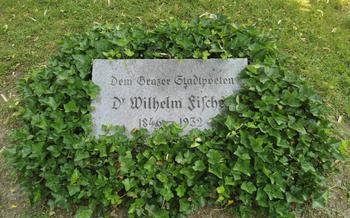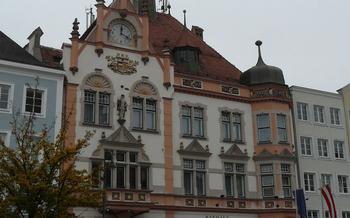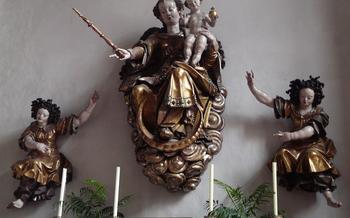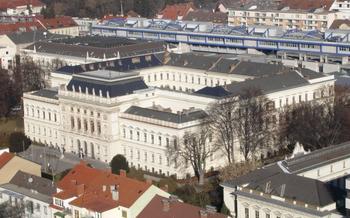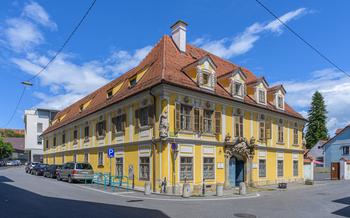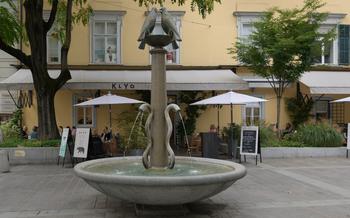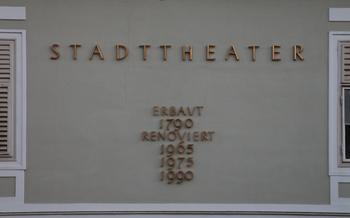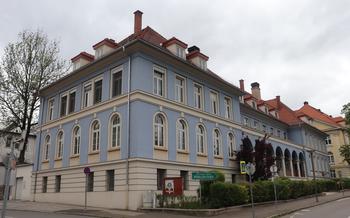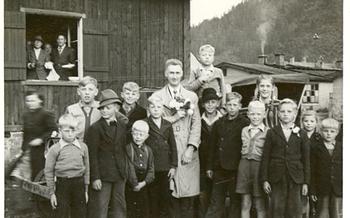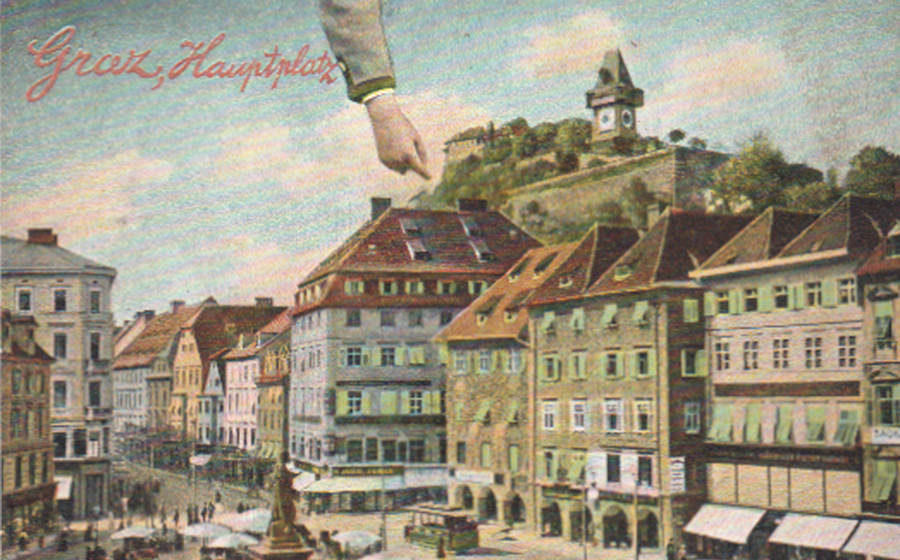
Wildon Castle Ruins
- Wildon Castle Ruins: An Overview
- Historical Significance
- Architectural Features
- Exploring the Ruins
- Legends and Folklore
- Events and Activities
- Natural Surroundings
- Nearby Attractions
- Practical Information
- Accessibility
- Local Cuisine
- Accommodation
- Photography Tips
- Off-the-Beaten-Path
- Insider Tip: Unveiling the Secret Stairway
Wildon Castle Ruins: An Overview
Perched atop a hill overlooking the idyllic town of Wildon, the imposing ruins of Wildon Castle stand as a testament to a rich and storied past. Dating back to the 12th century, the castle played a pivotal role in the history of Styria, serving as a strategic stronghold and the ancestral seat of the powerful Wildon family. Over the centuries, the castle underwent numerous expansions and modifications, reflecting the changing architectural styles and the evolving needs of its inhabitants. Today, the ruins offer visitors a glimpse into the grandeur of a bygone era, inviting them to explore the remnants of a once-mighty fortress and to unravel the captivating tales that echo within its crumbling walls.
Situated approximately 15 kilometers southeast of Graz, the capital of Styria, Wildon Castle Ruins are easily accessible by car or public transportation. The castle is open to the public year-round, with guided tours available during the summer months. As visitors approach the ruins, they are greeted by an awe-inspiring sight: a hulking mass of stone rising majestically against the backdrop of the surrounding hills. The castle's layout is characterized by a series of concentric walls, towers, and courtyards, each revealing a different chapter in its long and eventful history.
Historical Significance
Wildon Castle played a pivotal role in the history of Styria, a state in southeastern Austria. Constructed in the 12th century, the castle served as the seat of the Counts of Wildon, a powerful and influential family in the region. During the Middle Ages, Wildon Castle was a significant defensive stronghold, protecting the surrounding lands from invaders and marauders. It also served as an administrative center, where the counts exercised their authority and dispensed justice.
Throughout its history, Wildon Castle witnessed numerous notable events and hosted prominent figures. In the 14th century, the castle was besieged by the forces of the Habsburg dynasty, who eventually conquered Styria and incorporated it into their vast empire. During the 16th century, the castle was owned by the Herberstein family, who played a significant role in the Protestant Reformation in Austria.
In the 17th century, Wildon Castle was damaged by a fire and gradually fell into disrepair. It was eventually abandoned and left to ruin. However, the castle's historical significance ensured its preservation, and in the 19th century, it was declared a protected monument. Today, the ruins of Wildon Castle stand as a testament to the rich history of Styria and attract visitors from around the world.
Architectural Features
The architectural features of Wildon Castle Ruins are a testament to its rich history and strategic importance. The castle comprises several distinct sections, each with its own unique characteristics. The keep, or central tower, is the most prominent feature of the ruins, reaching an impressive height and offering panoramic views of the surrounding landscape. The courtyard, enclosed by high walls and towers, once served as the main living and working space for the castle's inhabitants. The outer walls, reinforced with buttresses and loopholes, provided a strong defense against potential attackers.
Among the unique architectural elements of Wildon Castle Ruins are the Romanesque windows, which feature rounded arches and intricate carvings. The Gothic gate, with its pointed arch and delicate tracery, is another notable feature. The castle's strategic location atop a hill overlooking the Mur River further enhanced its defensive capabilities and allowed for effective control of the surrounding territory.
Exploring the Ruins
Venturing through the ruins of Wildon Castle is a captivating experience that transports visitors back in time. To fully appreciate the site's historical significance, it's advisable to follow suggested routes and viewpoints that highlight key features and offer stunning perspectives.
One recommended route begins at the castle's entrance, where visitors are greeted by the impressive gatehouse. From here, a path leads to the inner courtyard, which once served as the heart of the castle. Surrounding the courtyard are the remains of various buildings, including the chapel, well, and dungeon. Each of these structures offers a glimpse into the daily life and activities that took place within the castle walls.
Another highlight of the ruins is the keep, the tallest remaining structure. Visitors can climb the narrow staircases to reach the top of the keep, where they are rewarded with breathtaking panoramic views of the surrounding countryside. From this vantage point, one can truly appreciate the castle's strategic location and its role in controlling the surrounding region.
While exploring the ruins, it's crucial to remember the site's historical significance and treat it with respect. Visitors are encouraged to refrain from climbing on the walls or damaging any structures. By preserving the integrity of the ruins, future generations can continue to enjoy and learn from this remarkable piece of history.
Legends and Folklore
Wildon Castle Ruins is steeped in a rich tapestry of legends and folklore that have been passed down through generations. One of the most enduring tales is that of the "White Lady," a mysterious figure said to haunt the ruins. According to legend, the White Lady is the spirit of a young woman who was unjustly imprisoned and starved to death within the castle walls. Her ghost is said to appear on moonlit nights, searching for her lost love.
Another popular legend associated with the castle is that of the "Golden Treasure," said to be hidden somewhere within the ruins. Many have searched for the treasure, but none have ever been successful. These legends and myths add an air of mystery and intrigue to Wildon Castle Ruins, capturing the imaginations of visitors and locals alike. They play a significant role in the local culture and tourism, attracting visitors who are eager to experience the magic and history of the site.
Events and Activities
Wildon Castle Ruins is not merely a historical site; it also serves as a vibrant cultural and community hub. Throughout the year, the ruins host a variety of events and activities that cater to diverse interests and age groups.
One of the highlights is the annual Wildon Castle Festival, which takes place during the summer months. This lively festival features live music performances, traditional Styrian dances, medieval reenactments, and a bustling medieval market. Visitors can immerse themselves in the atmosphere of a bygone era, sample local delicacies, and enjoy the festive ambiance.
For those seeking a more educational experience, guided tours of the castle ruins are available throughout the year. Knowledgeable guides provide insights into the history, architecture, and legends associated with the site. Guided tours are offered in multiple languages, ensuring that visitors from all over the world can appreciate the significance of Wildon Castle.
Families with young children will find plenty to enjoy at the castle ruins as well. Interactive educational programs and workshops are organized regularly, allowing kids to learn about history and archaeology in a fun and engaging manner. The spacious grounds provide ample space for children to run, play, and explore, making a visit to Wildon Castle a memorable family outing.
Natural Surroundings
The Wildon Castle Ruins are not only a historical gem but also a natural beauty nestled within the serene Wildon Nature Park. The verdant landscape that envelops the ruins creates a picturesque backdrop, inviting visitors to immerse themselves in the tranquility of nature.
The park boasts a diverse array of flora and fauna, providing opportunities for nature enthusiasts to spot colorful wildflowers, observe various bird species, and encounter friendly squirrels scampering through the trees. The gentle murmur of the nearby creek adds to the peaceful ambiance, creating a perfect setting for relaxation and contemplation.
The ruins' location within the nature park offers visitors the chance to combine their historical exploration with outdoor activities. Visitors can embark on scenic walks along well-marked trails, enjoying the fresh air and admiring the natural wonders surrounding the castle. Picnic spots dot the park, allowing visitors to savor regional delicacies while basking in the beauty of their surroundings.
Nearby Attractions
Wildon Castle Ruins is not the only historical attraction in the region. In fact, it is surrounded by a wealth of other sites and landmarks that are worth exploring. For those interested in delving deeper into the history of Styria, a visit to the nearby town of Leibnitz is a must. Leibnitz Castle, with its impressive Renaissance architecture, is a particularly noteworthy attraction.
For those seeking a more varied experience, a day trip to Graz, the capital of Styria, is highly recommended. Graz boasts a stunning Old Town, designated as a UNESCO World Heritage Site, with numerous historical buildings, museums, and art galleries. The Eggenberg Palace, with its magnificent Baroque gardens, is a must-see attraction.
Beyond the immediate vicinity of Wildon, the region offers a variety of other destinations that are easily accessible by car or public transportation. The Riegersburg Castle, perched atop a volcanic hill, is a spectacular sight and offers insights into medieval life. The Lipizzaner Stud Farm in Piber is a unique attraction, where visitors can witness the training of these world-renowned horses.
Combining a visit to Wildon Castle Ruins with other regional attractions allows visitors to create a comprehensive itinerary that showcases the rich history and diverse landscapes of Styria. Whether exploring the medieval towns, visiting magnificent castles, or immersing themselves in the region's natural beauty, travelers will find plenty to captivate their interests.
Practical Information
Opening Hours and Admission Fees
Wildon Castle Ruins is open to the public year-round, with varying hours depending on the season. During the summer months (April to October), the ruins are open from 9 am to 6 pm, while in the winter months (November to March), they are open from 10 am to 4 pm. Admission fees are reasonable, with adult tickets costing around €5 and reduced rates for children, students, and seniors.
Guided Tours and Multilingual Information
Guided tours of Wildon Castle Ruins are available in English and German, providing visitors with a deeper insight into the history and significance of the site. These tours can be booked in advance or arranged upon arrival, subject to availability. Multilingual information panels are also displayed throughout the ruins, ensuring that visitors from all over the world can learn about the site's rich history.
Planning Your Visit: Itineraries and Transportation
To make the most of your visit to Wildon Castle Ruins, it is recommended to set aside at least two hours for exploring the site. Visitors can follow suggested itineraries that highlight the most important features of the ruins, including the keep, courtyard, and chapel. Wildon is easily accessible by car, with ample parking available near the castle. Public transportation options are also available, with buses running from Graz and nearby towns.
Accessibility
Wildon Castle Ruins is committed to ensuring that all visitors, regardless of their abilities, can enjoy and appreciate this historical site. The castle grounds are wheelchair accessible, with ramps and designated parking spaces available. Visitors with visual impairments can request audio guides or tactile maps to help them navigate the ruins. Additionally, the castle offers sign language interpretation upon request for visitors who are deaf or hard of hearing. The staff at Wildon Castle is dedicated to providing a welcoming and inclusive environment for all visitors, ensuring that everyone has the opportunity to explore and learn about this remarkable historical site.
Local Cuisine
In the heart of Styria, where Wildon Castle Ruins stand, a rich culinary tradition awaits. Indulge in traditional Styrian dishes that have been passed down through generations, embodying the region's unique flavors and heritage. Sample hearty stews like "Steirisches Wurzelfleisch" or savor the delicate taste of "Kürbiscremesuppe," a velvety pumpkin cream soup. Don't miss the region's signature dish, "Backhendl," a crispy fried chicken that will tantalize your taste buds.
For a sweet treat, try "Apfelstrudel," a classic apple strudel bursting with flavors, or indulge in the melt-in-your-mouth goodness of "Kaiserschmarrn," a fluffy shredded pancake served with powdered sugar.
To enhance your culinary experience, visit local restaurants and eateries near Wildon Castle Ruins, where passionate chefs showcase their culinary artistry. Immerse yourself in the warmth and hospitality of Styrian establishments as you savor the region's culinary delights. Supporting local cuisine not only nourishes your body but also contributes to preserving the cultural heritage of this charming region.
Accommodation
When planning a visit to Wildon Castle Ruins, finding suitable accommodation in the area is essential. Fortunately, there are various options available to cater to different preferences and budgets.
Within Wildon itself, there are several charming hotels and guesthouses that offer a range of amenities and comfortable accommodations. These establishments often provide a cozy and authentic atmosphere, allowing visitors to immerse themselves in the local culture.
For those seeking more seclusion and independence, vacation rentals are an excellent choice. Several picturesque cottages, apartments, and farmhouses can be found in the surrounding countryside, offering stunning views and a peaceful retreat.
It's important to note that Wildon is a popular tourist destination, especially during the summer months. To avoid disappointment and secure the best accommodations, booking in advance is highly recommended, particularly if traveling during peak season.
Whether opting for a cozy hotel in the heart of Wildon or a secluded vacation rental amidst the countryside, visitors are sure to find the perfect place to rest and recharge after a day of exploring the captivating Wildon Castle Ruins and its surroundings.
Photography Tips
Wildon Castle Ruins offer a wealth of opportunities for capturing stunning photographs. Whether you're a seasoned photographer or simply looking to capture some memorable shots, here are a few tips to help you make the most of your visit:
-
Golden Hour Magic: Plan your visit during the golden hours, just after sunrise or before sunset, to capture the most flattering light. The warm hues of the rising or setting sun will add depth and drama to your photographs.
-
Explore Different Angles: Don't just stick to the obvious viewpoints. Take some time to explore different angles and perspectives around the ruins. Look for interesting compositions that showcase the castle's unique architectural features or its relationship to the surrounding landscape.
-
Capture the Details: While it's tempting to focus on sweeping vistas, don't forget to capture the intricate details of the ruins. Close-ups of weathered stonework, crumbling walls, or delicate carvings can add a sense of intimacy and authenticity to your shots.
-
Utilize Natural Light: Make the most of the natural light available. Avoid using flash, as it can create harsh shadows and detract from the ruins' natural beauty. Instead, use the ambient light to create softer, more atmospheric images.
-
Respect the Site: Remember that Wildon Castle Ruins are a historical site. Be respectful of the ruins and their surroundings. Avoid disturbing the natural environment or damaging any structures or artifacts.
Off-the-Beaten-Path
Beyond the main ruins, there are hidden gems waiting to be discovered in the surrounding countryside. A short walk from the castle, nestled among rolling hills, lies the Wildon Abbey, a former Augustinian monastery founded in the 12th century. Its well-preserved Romanesque architecture and serene atmosphere offer a glimpse into the region's rich religious history.
For those seeking a unique perspective of the ruins, venturing off the beaten path leads to a hidden viewpoint atop a nearby hill. This secluded spot offers panoramic vistas of the castle, the surrounding vineyards, and the distant Styrian Alps, creating a breathtaking backdrop for capturing unforgettable photographs. Remember, the path to this viewpoint may be less traveled, so proper footwear and caution are advised.
Exploring the picturesque villages and hamlets nestled around Wildon Castle Ruins reveals additional hidden treasures. The village of St. Johann im Saggautal, just a few kilometers away, boasts a charming 13th-century church and a well-preserved medieval town center, transporting visitors back in time.
These lesser-known destinations offer a chance to delve deeper into the region's history and culture, providing a more immersive and authentic travel experience. Embrace the opportunity to wander off the beaten path, uncover hidden gems, and create lasting memories in the enchanting landscapes surrounding Wildon Castle Ruins.
Insider Tip: Unveiling the Secret Stairway
Beyond the main tourist routes, Wildon Castle Ruins holds a hidden gem – a secret stairway concealed within the crumbling walls. This forgotten passageway once served as a strategic escape route for the castle's inhabitants during times of siege. Today, adventurous visitors can uncover this hidden treasure by carefully navigating the winding corridors and staircases.
To find the secret stairway, start by exploring the eastern section of the ruins, where you'll discover a series of interconnected chambers. Keep an eye out for a narrow, unassuming doorway tucked away in a corner. Once you've located the entrance, duck through the low archway and begin your ascent. The stairway is steep and narrow, but the reward at the top is well worth the effort.
Emerging from the shadows, you'll find yourself in a secluded tower overlooking the castle grounds. From this vantage point, you can enjoy breathtaking panoramic views of the surrounding countryside, stretching from the rolling hills of Styria to the distant peaks of the Alps. Take a moment to savor the tranquility of this hidden sanctuary, far from the hustle and bustle of the main tourist areas.
Remember, this secret stairway is a fragile relic of the past, so please tread carefully and respect the historical significance of the site. Share this insider tip with fellow travelers who appreciate the thrill of discovery, but keep the secret to yourself to ensure that this hidden gem remains a magical experience for future visitors.

